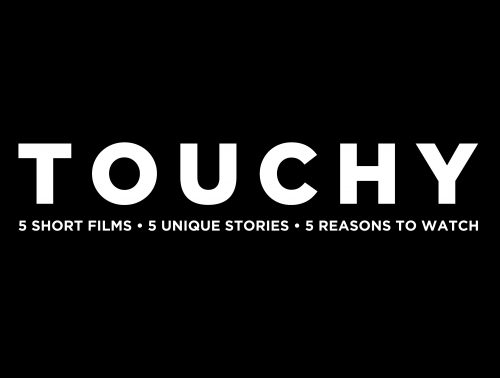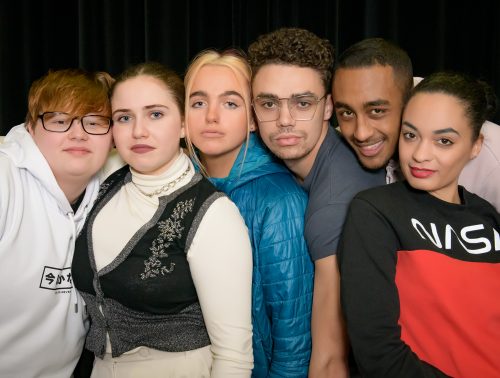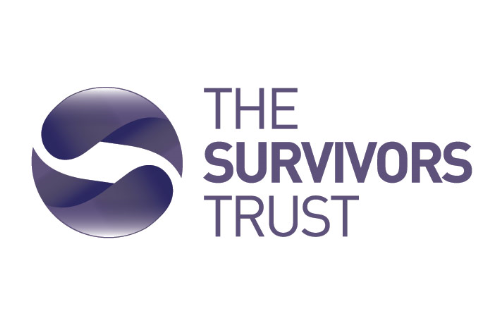TOUCHY
Five short films, five unique stories, five reasons to watch.
Touchy is a project made by 20 Stories High in collaboration with six Liverpool-based artists. In May 2021, we’ll release each film weekly, and they will be available to watch on YouTube and Instagram for a while after. We start with Jemell’s story, moving through the weeks to Max’s story at the end.
Self-care toolkits are available for all five films (or as one combined toolkit).
About Touchy
A mash up of theatre and music video – interweaving beats, drama, poetry, animation, visuals and original music. We follow the journey of six characters as they navigate their way through the tactile highs and lows of young adulthood.
WHY THIS TOOLKIT?
This toolkit has been designed to offer support to anyone engaging with the film, especially anyone who might be impacted by its content. We hope this toolkit provides you with specialist resources and tools from the professionals that may help.


Max’s Story
Max, a young trans guy guides us through his discoveries around social touch with a funny and heart-warming animation.
Content Overview
Max’s story is told through an accessible and light-hearted animation. It explores social touch, gender identity and the experience of transitioning.
Suitable for ages 13 plus.
There is a detailed breakdown of what story they tell at the end of this pack, please read it ahead of watching if you would like further information.


Go at your own pace:
If you don’t want to watch this all at once, maybe consider watching the film a bit at a time. Max’s story is told through a fun, animation and is seven minutes long in total. It’ll be available on YouTube and Instagram for the next few years at least. Do what feels right for you.
Watch with someone:
Watching with someone who knows you and any connections you may have to the theme of this film may help when it comes to recognising if you need to switch it off, or if you need support. Or if you can’t watch with someone, maybe message someone ahead of watching, and let them know you might call them if you need support.
Read a summary of the film:
If you would like to know the content before you watch, so that there is nothing unexpected, you will find a full breakdown of the piece at the bottom of this document.
Remember it is your choice:
Remember it is your choice to watch this film – you are in the driving seat. There should never be any pressure to do otherwise. You are in control, even if you might not feel it. If you are feeling overwhelmed at any point, turn the film off and try some grounding techniques.
Remember your breath:
If you become triggered, breathing is a great way to bring yourself back into a state of calm, lower your heart rate and create space in your brain to start thinking things through at an easier pace. Try breathing in for four seconds, holding your breath for four seconds, exhaling for four seconds and holding again. Repeat this for as long as you need until your breath feels in control again. Lots of mobiles and smart watches offer apps which can help you with this.
Get some fresh air:
Going for a walk or even just standing outdoors can help.
Get help:
If you notice that you have become overwhelmed – and the techniques suggested here or techniques that usually bring you calm have not this time – then you recognise that and consider getting professional support. See the bottom of this document for helplines and organisations who can help.
Advice taken from The Survivor’s Trust blog: Taking Care of yourself & I May Destroy You – find more advice and tips here: https://bit.ly/3v6rw2H – this article was created by The Survivor’s Trust in order to help viewers in making the choice to watch the TV series I May Destroy You. Although our Touchy films have differing themes, the ideas and tips are relevant for lots of shows and films that may be triggering.


Mermaids UK
0808 801 0400
Supporting gender-diverse kids, young people and their families.
Trans Unite
Access over 100 verified UK Trans support groups and locate one close to you.
The LGBT Foundation
0345 3 30 30 30
Aa national charity delivering advice, support and information service to lesbian, gay, bisexual and trans communities.
Stonewall
0800 050 2020
A national charity for empowering individual, changing and protecting laws, changing hearts and minds and transforming institutions.
Young Stonewall
0800 050 2020
We’re here to let all young lesbian, gay, bi and trans people – as well as those who are questioning – here and abroad, know they’re not alone.
GYRO Liverpool
www.liverpoolcamhs.com/support/gyro-ypas
Support line (24/7): 0151 293 3577
GYRO is a collection of groups for young people who identify themselves as: Lesbian, Gay, Bisexual or Trans, or who are Questioning their sexuality or gender identity (LGBTQ+)
MindOut
01273 234839
Lesbian, Gay, Bisexual, Trans and Queer Mental Health Service
Not sure where to turn?
The Mix offers a wide range of support for young people under the age of 25.
www.themix.org.uk (for 1-2-1 chat and messenger)
0808 808 4994
Useful apps:
- Hub of Hope
- Woebot
- Headspace
- Calm



Synopsis of the Film: Max’s story
Max’s story is told through an accessible and light-hearted animation. It explores social touch, gender identity and the experience of transitioning. There is beatboxing music and sound effects throughout the piece.
The story starts with the image of a person, walking silently against a grey and white silhouette of the Liverpool city skyline. The person stops, faces the screen, and waves. A voiceover introduces the person as Max, a lad from Liverpool. Max talks about the ups and downs over the past year, and how much he has personally enjoyed the ‘two-metre-distance rule’.
Max begins walking across the screen. The voice-over talks about how he experienced anxiety growing up, in what felt like the wrong body. He then talks about transitioning, and especially exploring social touch and greetings. Purple bubbles pop up on the screen of different images of hand-greetings. Max talks about how he mentioned his anxiety to his mates. An animated image of two other people arrives, and they walk alongside Max. He talks about how his other male friends feel anxiety about social touch and greetings too.
Bubble writing appears on the screen and Max introduces ‘Max’s Guide to Touchy-Feeling Social Interaction for Lads Everywhere’, he adds: ‘and people on the masculine end of the gender spectrum’. He starts walking across the skyline again – and introduces the first interaction: ‘the nod’. Max talks about how this non-contact social interaction is good for acknowledging people who you see throughout the day or only vaguely know. A blue puff of smoke fills the screen, and the background changes to the silhouetted image of a supermarket. Max walks past another customer in the supermarket and demonstrates ‘the nod’.
A blue puff of smoke fills the screen, and the city skyline silhouette returns, and Max introduces ‘the handshake’. Max talks about how, before he was transitioning, this greeting was not one he was familiar with but since, he has realised how this greeting is formal and loaded with hormones. Max continues walking and talks about the detail of ‘the handshake’ e.g. how hard you squeeze, who lets go first. A person in a blue suit enters the screen. Max walks up to them and they shake hands. He then talks about meeting the area manager at Greggs and how he judged their limp handshake. The image of Max changes, his arm grows muscley and the person in the blue suit starts to sweat. Max questions whether the testosterone that he has been taking for the past year is impacting on his experiences and how it is a greeting he will steer clear of in the future.
Blue clouds of smoke fill the screen and the person in the suit disappears. Max starts walking again. He introduces the next introduction: ‘the fist bump’. The word appears on the screen, followed by an image of two fists meeting together at the knuckles. Max talks about how his mates greet him most of the time using this greeting, and that he normally cringes from it – not because he doesn’t think he’s cool but because it doesn’t feel authentic to him. A person with a skateboard enters the screen, and fist bumps Max. Max offers advice to only partake in greetings if you feel comfortable with it.
Max introduces the next greeting: ‘the high five’. An image of two hands facing each other comes up on the screen. Max talks about how he wasn’t sure whether to include this greeting because he normally only uses it as an ironic celebration. Max starts walking again and says that this greeting works really well for some people. A person enters the screen, who has long grey hair. Max talks about how his drama teacher Tony in college tried to high-five him in the canteen once. The person waves his hand in the air at Max, but Max explains how he left him ‘hanging’ and walks past him.
The words ‘sorry Tony’ flash on the screen and Max talks about how he hopes that Tony, his drama teacher, finds his high-five tribe soon.
Max continues walking and introduces the next greeting: the ‘palm grab’. He talks about how in America, it is called ‘DAP’ which stands for Dignity and Pride and has origins in greetings between African American soldiers in the 1950’s. Max talks about the variations of the DAP and says that this is the greeting he feels comfortable using with his lad mates.
We see an image of another person enter the screen. Max greets him with a DAP and gets pulled into an ‘arm hug’. Max says that this is what you need to look out for with the DAP/palm grab but explains that an ‘arm hug’ is just a couple of pats on the back and then a release. The other person leaves, and Max starts walking again.
The final greeting that Max introduces is ‘the full-on hug’. We see an image of two men hugging. Max says that this isn’t the greeting for him and explains that the only time he has hugged someone in a greeting is when his mate, Dwayne’s guinea pig was eaten by his nan’s dog and how he could see Dwayne needed a hug. He warns that this is reserved for people on the touchy-feely end of the spectrum. Max starts walking again and summarises how these are some of the greetings that masculine types use. He talks about how he left out greetings like ‘the chest pump’, as an image of two men bumping their chests together appears. This image disappears, and Max talks about the next greetings he wants to figure out. An image of the word ‘girl’ fills the screen and Max walks straight into the side of the ‘G’.
An image of a girl appears. Max says that this is Daisy, his best mate. He doesn’t know how to greet her because the boundaries she has with her other lad mates, don’t apply to him. Daisy still greets Max in the same way that she did before he transitioned, with a hug and squeeze. He feels like she might not see him as a ‘man’. Daisy disappears from the screen, and Max keeps walking with his head down. He understands that Daisy might miss the old Max, but he just has a new set of pronouns.
Max starts walking again and talks about how he is thinking of sitting down with Daisy in the park and talking it through with her about what to do when they greet – something that works for them both. An image of two people sat on a bench facing the sun comes on the screen. Max says he will be careful with the conversation though because the last thing he wants is Daisy to think he is someone with too much testosterone.






Further Information
What does “trans” mean?
Trans is often used as shorthand for transgender. Transgender people are people whose gender identity is different from the sex that they were ‘labelled’ at birth. Based on what our bodies look like when we are born, a doctor usually says that we are male or female (our Sex). Many people identify with their sex at birth as their gender identity, but some people don’t. Most of these people describe themselves as transgender, or transitioning. For example, a transgender woman lives as a woman but was labelled as a male when she was born, and a transgender man lives as a man but was labelled as a female when he was born. Some transgender people identify as neither male nor female, or as a combination. This group of people sometimes use the term non-binary or genderqueer to identify themselves.
Being transgender means different things to different people. Like a lot of other aspects of who people are (e.g. race or religion), there is no one way to be transgender, and no one way for transgender people to look or feel about themselves. The best way to understand the transgender community is to talk with transgender people. It is okay to ask questions if the person you are talking to is happy to answer them. Some trans people feel comfortable discussing their identity, others don’t. If you say the wrong thing by accident, just apologise, recognise you have got it wrong and move on. As long as you have good intentions, most trans people will appreciate a real, honest and respectful conversation.
What does “gender transition” mean?
Gender transitioning is the time when an individual starts to live according to their gender identity, rather than the one they were thought to be at birth. Not all transgender people transition, and transitioning looks different for every person. Possible steps in a gender transition may (or may not) include changing clothing, appearance, name, or the pronoun people use (e.g. she/ he/ they). Some people change their identification documents, like their driver’s license or passport, to reflect their gender. Some people undergo hormone therapy or other medical procedures to change their physical characteristics – this makes their body better reflect the gender they identify with. No specific set of steps is necessary to “complete” a transition – it is a matter of what is right for each person. All transgender people are entitled to the same dignity and respect, regardless of which legal or medical steps they have taken. It’s important to note that transgender people can often find this process overwhelming, difficult, stressful and time-consuming. There are lots of barriers that transgender people face in order to transition – such as long waiting lists for medical assessments and appointments, inequality due to society widely accepting ‘Male’ or ‘Female’ as the only two genders and age limits put in place for things such as hormone treatments meaning they are only available to those over the age of 18.
How do you know if you are trans?
Many people know that they are trans from a young age. Some people can trace their awareness back to their earlier memories – they just knew. Others may need more time to realise that they are transgender. Trans people might not have the language or understanding of what it means until later in life. Some people may spend years feeling like they don’t fit in, without really understanding why – or feel fear, shame, or confusion. Trying to repress or change your gender identity can be very painful and damaging. It is not something that is a ‘lifestyle choice’, or something that comes and goes with time. It is an essential part of who you are.
As transgender people become more visible in the media and wider community, other transgender people can name and understand their own experiences and may feel safer and more comfortable sharing it with others. For many transgender people, recognising who they are and deciding to start gender transition can take a lot of reflection because of social stigma, discrimination, and harassment. Despite those risks, being open about your gender identity, and living a life that feels truly authentic, can be a life-affirming and even life-saving decision.
How can I be a good ally to the trans community?
An ally is someone who does not identify within the ‘trans’ umbrella but supports the trans community and their political struggles. When you become an ally of transgender people, your actions will help change culture, making society a better, safer place for everyone (trans or not). GLAAD has put together some useful tips:
- Listen for people’s pronouns first (he /she/ they) or politely ask
- Be careful about confidentially – some people feel comfortable about disclosing their gender history, others do not
- Be patient with a person who is questioning or exploring their gender identity – sometimes it takes time to figure out what feels authentic
- Understand that transitioning is different for every person
- Support all-gender public toilets
- Set an inclusive tone – e.g. you can say “the person in the blue shirt” rather than “the man in the front row”
- Take a visible stand against hate crime. Call out anti-trans jokes, remarks or abuse whenever you see it, so long as it is safe to do so
- Support those being targeted by letting them know you are an ally
- Let local business owners know if you witness an anti-trans incident from staff or other customers, so that they can tackle it.
- Report incidents of transphobic discrimination when accessing public services (like housing or social services) to the service provider or local council so they can take action
Information taken from Stonewall, National Centre for Transgender Equality (USA) and GLAAD.
Photos by Wesley Storey (Please note these photos were taken in 2019, prior to implementation of Covid-19 restrictions).
Artwork by Joe Harper.


